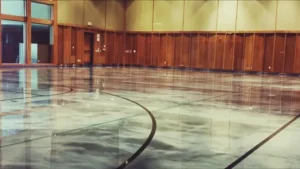Epoxy floors are popular in garages, basements, commercial facilities, and industrial sites because of their durability, chemical resistance, and aesthetic appeal. But like any floor, they will deteriorate eventually. The question is: how long? The answer depends on many variables including usage, installation quality, environmental factors, and maintenance. This article discusses typical lifespans, main factors affecting durability, common failure modes, and tips for getting the maximum life out of your epoxy floor.
Typical Lifespan of Epoxy Flooring
Some sources report even longer lifespans (20–30 years) in favourable conditions (low traffic, excellent care, stable environment) for residential epoxy systems.
Key Factors That Affect Epoxy Floor Lifespan
Here are the main variables that influence how long an epoxy floor will last:
Quality of the Epoxy Product
- There are different formulations: 100% solids epoxy, water-based, solvent-based etc. The more solids (i.e. less volatile carriers), generally the more durable.
- Topcoats, additives (e.g. UV blockers), fillers or aggregates also affect performance.
Thickness of Coating / Number of Layers
- Thicker coats resist wear better. A primer + base coat + top coat system will last longer than a single thin layer.
- If there are aggregates (like grit or quartz) embedded, they help against abrasion.
Surface Preparation & Installation Quality
- Perhaps the single most important factor. If the concrete slab is not cleaned, degreased, ground or etched properly; if cracks are not repaired; if moisture vapor is ignored — the epoxy adhesion might fail early.
- Curing conditions (temperature, humidity) also matter. If epoxy is applied under very hot, cold or humid conditions, it may cure improperly and degrade faster.
Level and Type of Traffic / Use
- Foot traffic vs vehicle traffic vs heavy machinery makes a big difference. Heavy rolling or sharp abrasion will accelerate wear.
- Spills (oil, chemicals) and repeated exposure to harsh substances can degrade the top layer if not cleaned promptly.
Environmental Exposure
- UV light: Many epoxies yellow, degrade or lose gloss under UV unless there is a UV-stable topcoat.
- Moisture and substrate movement: moisture vapor from concrete, or structural movement, leads to bubbling, delamination.
- Temperature fluctuations (hot-cold cycles) can also put stress on the epoxy, leading to cracking or crazing (fine cracks in the surface).
Maintenance & Repair
- Regular cleaning, avoiding abrasive cleaners, catching spills early, using mats or protective pads under heavy loads help a lot.
- Recoating or refreshing the top layer every few years (especially in high-traffic zones) can add years.
Common Signs of Wear & When to Recoat or Replace
Even well-installed epoxy floors eventually show signs of aging. Here are what to look for:
- Loss of gloss or dull patches, especially in high-traffic areas.
- Visible scratches, gouges, or surface chips.
- Discoloration or yellowing (often from UV or chemical exposure).
- Delamination: edges lifting, bubbles, peeling.
- Cracking or crazing.
- Persistent stains that don’t clean out.
If such signs appear, a partial or full recoat may be needed. Sometimes small damaged areas can be patched; sometimes full replacement gives better long-term value. Timing of maintenance can help prevent bigger issues and extend lifespan.

Epoxy Flooring vs Alternatives: Lifespan Comparisons
Knowing how epoxy performs relative to other flooring helps value the investment:
- Vinyl / Laminate / Carpet: usually need replacement every 5-15 years depending on usage. Epoxy in many cases lasts significantly longer.
- Polished Concrete: good lifespan (10-15 years), but less chemical resistance, less ability to resist stains, and less aesthetic variety. Epoxy improves many of those.
- Tile / Ceramic: can last long, but grout lines, cost of repairs, chips/cracks can reduce effective lifespan relative to epoxy in harsh environments.
How to Maximize the Longevity of Your Epoxy Floor
To get the highest possible life out of an epoxy floor, follow these guidelines:
Choose the Right Product
Use high quality epoxy suited for the expected load and environment. For outdoor or UV-exposed areas, pick UV-stable systems or clear topcoats. For chemical exposure, use chemically resistant formulations.
Ensure Proper Surface Preparation
Cleanliness, removal of old sealers, oils, dust; grinding or profiling; moisture testing; fill cracks; ensure the concrete is structurally sound. Proper prep is often what separates epoxy floors that last 20+ years from those failing in 2-5 years.
Apply Adequate Thickness / Layers
Include primer, base coat, possibly decorative layers, then a protective top coat. Make sure each layer is properly cured before applying next. Avoid shortcuts.
Protect from Immediate Abuse
Use mats at entries, pads under furniture or machinery, avoid dragging sharp items, avoid tires with hard compounds that get very hot (in garages) etc.
Maintain Regularly
Sweep/dust mop frequently to remove grit; mop with pH-neutral cleaners; clean spills immediately; avoid harsh chemical cleaners unless epoxy-rated.
Recoat When Necessary
Even a good epoxy floor may benefit from refreshers—especially in high traffic zones or where the top coat is showing wear signs. Doing so before damage becomes severe helps extend lifespan.

Example Scenarios (Residential vs Commercial vs Industrial)
To illustrate, here are some example lifespans based on use:
- A suburban garage not heavily used, protected from UV, cleaned often → 15-20+ years or even longer.
- A basement with occasional foot traffic and moderate environmental stability → 12-20 years.
- A showroom with moderate foot traffic, occasional chemical spills → 10-15 years.
- Warehouse floor with forklift usage, heavy loads, high abrasion, chemical exposure → 5-10 years (or less if maintenance is weak).
Conclusion
Epoxy flooring is a strong, durable, and long-lasting flooring choice. With proper product selection, careful installation, consistent maintenance, and attention to environmental factors, epoxy floors can last 10 to 30 years, depending mainly on usage and care. In high-stress or industrial applications, expect shorter lifespans unless extra protections are built in. But even then, epoxy often outperforms many alternatives in total lifetime cost and durability.

